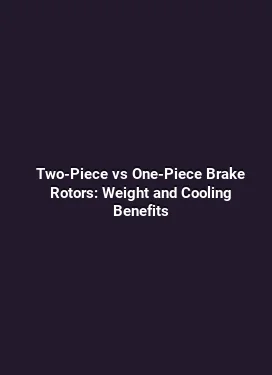Brake Bias Adjustment Guide for Optimal Front and Rear Balance
Achieving the right brake balance between the front and rear axles is crucial for predictable stopping performance, tire longevity, and driving confidence. This guide delves into the principles behind brake bias, signs of imbalance, and practical methods to dial in the balance across different driving scenarios. By understanding how each component contributes to pedal feel, fade resistance, and overall braking stability, enthusiasts and professionals can fine-tune their systems with data-driven decisions.
Foundations of Front-to-Rear Brake Balance

Brake bias refers to the distribution of braking force between the front and rear axles. In most passenger vehicles, the majority of stopping power comes from the front wheels due to weight transfer during deceleration. However, excessive front bias can lead to underutilized rear brakes, while too much rear bias may provoke rear-wheel lockup or instability, especially on low-grip surfaces. The optimal balance depends on vehicle weight distribution, dynamics, tire characteristics, and driving conditions.
When the driver applies the pedal, hydraulic pressure travels through the master cylinder, partitions of the braking system, and to each caliper. The ratio of pressure delivered to the front versus rear calipers determines how much deceleration each axle experiences. Subtle adjustments can alter pedal firmness, bite point stability, and modulation, all of which influence how the car behaves under heavy braking, during corner entry, and when transitioning to corner exit power.
Key Components Influencing Brake Bias
Several elements shape the effective bias of a braking system. Understanding their roles helps in diagnosing why a car may feel nose-heavy or rear-biased during braking maneuvers.
Front Calipers, Pads, and Discs

Front components typically handle a larger share of stopping force due to weight transfer. The choice of pad compound, rotor material, and caliper pressure capability directly impacts initial bite, fade resistance, and thermal handling. Stiffer front systems can increase perceived bias toward the front, while high-friction pads with superior thermal capacity help maintain front grip under repeated braking.
Rear Calipers, Pads, and Discs
The rear braking system provides balance, stability at the limit, and charge for rear-wheel torque during braking. When rear components are less capable, the car may feel light on the rear and prone to oversteer or braking instability. Upgrading rear pads with higher thermal tolerance or adjusting pad compound can help stabilize the rear axle's contribution without sacrificing overall stopping power.
Hydraulic Distribution and Proportioning
The proportioning between front and rear hydraulic circuits is a fundamental way to set bias. Modern systems use fixed or adjustable proportioning valves, or integrated modules, to modulate the rear pressure relative to the front as braking demand increases. The aim is to maintain front grip while ensuring the rear brakes participate meaningfully without locking up under abrupt deceleration.
Approaches to Adjusting Brake Bias
Adjusting brake bias can be accomplished through multiple pathways, each with its own trade-offs between simplicity, cost, and effectiveness. The following methods span street-focused vehicles to track-driven setups.
Fixed Bias Adjustments and Tuning
A fixed bias adjustment changes the relative pressure delivered to the front and rear circuits, typically via a bias bar or a proportioning valve with a defined ratio. In many performance applications, technicians estimate the desired balance based on dynamic testing and then set the device to the target ratio. The outcome should feel linear and predictable, with front-end confidence under heavy braking and controlled rear activity as load transfers rearward.
Practical steps include: - Evaluating baseline bite and pedal travel at various speeds. - Measuring brake temperatures on the front and rear after a controlled stop to assess differential heating. - Adjusting in small increments, accompanied by on-track or closed-course testing to observe behavior changes with each change.
Adjustable Proportioning Valves and Modules
Proportioning devices provide a tunable method to alter rear pressure relative to front pressure. Mechanical valves, pneumatic assist modules, or electronic brake control units can offer adjustability across a range of temperatures and braking demands. When using these devices, it is essential to map the bias across the entire operating window, not just at a single stop. This ensures consistent feel from cold brakes to peak heat scenarios.
Best practices include: - Creating a bias map that spans cold, warm, and hot conditions. - Documenting the bias setting corresponding to each track surface or road condition. - Verifying integration with the vehicle’s stability and traction characteristics to prevent unintended rear instability.
Practical Testing and Data-Driven Evaluation
Effective brake bias tuning relies on repeatable tests that capture how the car behaves under braking load. The goal is to quantify changes in front grip, rear stability, and overall stopping distance while maintaining driver confidence. A combination of subjective feedback and objective measurements leads to robust results.
Test procedures to consider:
- Controlled stop tests from incremental speeds on a closed course to observe pedal feel, nose dive, and rear lift.
- Brake fade assessment by performing repeated stops with consistent cooldown between runs to monitor temperature effects on bias performance.
- Temperature mapping using infrared sensors or thermocouples on rotors and pads to ensure a balanced thermal profile across axles.
- On-track data collection with a data logger to correlate pedal pressure, brake pressure, wheel speeds, and yaw rate for a holistic view of system behavior.
Interpretation of data should focus on stability margins, recovery after locking tendencies, and how quickly the car can be brought back to equilibrium after heavy braking. Small, incremental adjustments guided by measurable improvements tend to yield the most reliable gains.
Common Scenarios and Tuning Considerations
Different driving environments demand nuanced bias settings. Here are several scenarios and corresponding tuning considerations to help practitioners tailor balance effectively.
Street Driving with Mixed Conditions
On everyday roads, bias should favor stable braking over aggressive performance. A conservative bias that avoids rear lockups on wet surfaces is often preferred. Consider gradual adjustments and prioritize a predictable pedal response rather than maximizing raw stopping power.
Additionally, tire health and wear patterns influence optimal bias. Worn front tires may benefit from a slightly rearward bias to maintain rotational compatibility and prevent abrupt front end loss of grip.
Track Day and Continental Endurance
Track environments demand robust fade resistance and rapid recovery. Front-heavy bias can help maintain overall deceleration capacity but may require careful attention to rear stability during late braking and corner entry. Track sessions often reveal the need for a balanced approach: enough front bite to manage speed and sufficient rear involvement to prevent nose-first braking behavior.
When pushing toward the limit, engineers may opt for a dynamic bias strategy, employing systems that adjust bias based on brake pressure, temperature, and vehicle dynamics in real time. This approach can maximize consistency across a wide range of loads while preserving driver feedback.
Maintenance, Durability, and Safety Considerations
Brake bias is not a one-time adjustment; it requires ongoing attention to ensure sustained performance. Routine inspection of hydraulic lines, seals, and master cylinder condition is essential because leaks or degraded components can alter pressure distribution and compromise balance. Brake fluid quality and boiling point also influence bias stability under heavy use.
Safety-oriented practices include monitoring pad and rotor wear across axles, avoiding asymmetrical wear that skews balance, and ensuring proper torques on caliper mounting hardware to prevent unintended changes in caliper alignment. Regular testing after component replacements helps confirm that the intended bias remains intact and reproducible under typical driving loads.
Integration with Vehicle Dynamics and Handling
Brake bias interacts with other dynamic systems, including suspension stiffness, tire grip, and weight distribution. A well-balanced braking system contributes to predictable yaw behavior, especially during threshold braking in corners. Conversely, misalignment between brake bias and suspension settings can amplify understeer or oversteer tendencies, reducing overall control at the limit.
Drivers may notice that a more forward bias reduces rear braking potency during corner entry, causing the rear to feel light. A more rearward bias can improve initial rotation but may increase the risk of lockup if the front tires lack sufficient grip. The objective is to cultivate a cohesive balance where braking actions complement the vehicle’s handling characteristics rather than fighting them.






